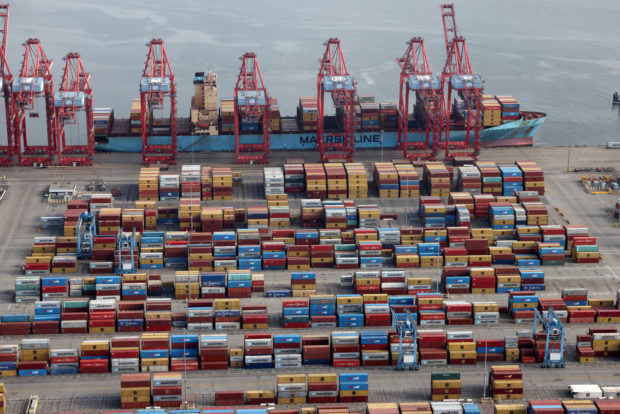
FILE PHOTO: Shipping containers are unloaded from a ship at a container terminal at the Port of Long Beach-Port of Los Angeles complex, in Los Angeles, California. REUTERS/Lucy Nicholson/File Photo
WASHINGTON – The U.S. trade deficit in goods narrowed sharply in June amid a surge in exports, which could potentially calm fears that the economy contracted again in the second quarter.
Gross domestic product last quarter also likely received a lift from business spending on equipment, with other data from the Commerce Department on Wednesday showing a solid increase in shipments of non-defense capital goods excluding aircraft in June. The reports were published ahead of the release on Thursday of the advance second-quarter GDP estimate.
A raft of soft housing data as well as weak business and consumer sentiment surveys had raised expectations for a second straight quarterly negative GDP reading, exacerbating worries of a recession.
“The upshot is that the second-quarter GDP figures due to be released tomorrow may show a stronger rebound than we had penciled in,” said Andrew Hunter, a senior U.S. economist at Capital Economics.
The goods trade deficit shrank 5.6 percent to $98.2 billion. Goods exports increased $4.4 billion to $181.5 billion. There were strong increases in exports of food and industrial goods. But fewer capital and consumer goods as well as motor vehicles and parts were exported.
Imports of goods fell $1.5 billion to $279.7 billion. They were pulled down by imports of motor vehicles and food. But imports of consumer and capital goods increased strongly.
The anticipated contribution to GDP from the smaller trade gap is likely to offset an expected drag from inventories. A slowdown in consumer spending last quarter is believed to have discouraged businesses from maintaining the same pace of strong inventory accumulation as in the first quarter.
Trade has subtracted from GDP for seven straight quarters. The Commerce Department also reported that wholesale inventories increased 1.9 percent in June, while stocks at retailers rose 2 percent.
Walmart on Monday slashed its profit forecast and said it needed more price cuts to pare inventories. Back in May, the retail bellwether said it was sitting on over $60 billion in inventory at the end of the first quarter.
Economic activity is cooling as the Federal Reserve aggressively tightens monetary policy to tame inflation. The U.S. central bank is expected to raise its policy rate by another 75 basis points later on Wednesday, which would bring the total interest rate hikes since March to 225 basis points.
Despite the rising interest rates and mounting recession fears, businesses are still investing in equipment. In another report on Wednesday, the Commerce Department said orders for non-defense capital goods excluding aircraft, a closely watched proxy for business spending plans, rose 0.5 percent last month.
These so-called core capital goods orders increased 0.5 percent in May. Economists polled by Reuters had forecast core capital goods orders would gain 0.2 percent. Orders increased 10.1 percent on a year-on-year basis in June.
Core capital goods shipments advanced 0.7 percent after rising 1 percent in May. Core capital goods shipments are used to calculate equipment spending in the gross domestic product measurement.
“Some of the increase is attributed to higher prices but the absence of a sustained decline in orders suggests that businesses are still investing despite tighter financial market conditions, drop in sentiment and worries about a recession,” said Ryan Sweet, a senior economist at Moody’s Analytics in West Chester, Pennsylvania.
Though shipments were partially boosted by higher prices, business spending on equipment likely contributed to GDP growth last quarter. According to a Reuters survey of economists, GDP increased at a 0.5 percent annualized rate in the second quarter.
The economy contracted at a 1.6- percent pace in the first quarter.

